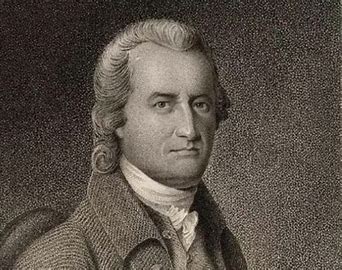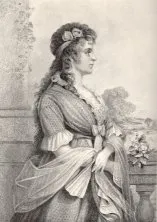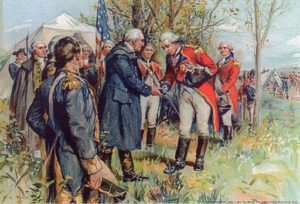
Oliver Wolcott was a wealthy and well-educated founding father. He signed the Declaration of Independence and the Articles of Confederation, but he was also a leader of militia who fought in the war. He began as a Captain and rose to the rank of major general by war’s end. Oliver served in many local, state, and federal positions, the last being governor of Connecticut.
Born on 20 November 1726 at Windsor, Connecticut, Oliver Wolcott was the fourteenth of fifteen children (eight survived childhood) and the youngest son of Royal Governor Roger Wolcott and Sarah Drake. The Wolcott and the Drake families were early settlers of New England and were prominent in local affairs.
Oliver graduated from Yale College in 1747 at the top of his class. He began his military career as a militia captain during King George’s War (1744-1748). He organized a militia unit that was part of an unsuccessful British expedition against the French in New France. This war accomplished nothing. Everything stayed the same as it was before the war.
After the war, Oliver returned to Goshen, Connecticut to study medicine with his brother, Dr. Alexander Wolcott. Oliver did not find medicine to be his calling. His father owned property in Litchfield, Connecticut so he moved there and took up the practice of law. He also set up a mercantile business.
The County of Litchfield was founded in 1751 and Oliver Wolcott was elected the first sheriff. He held this position for 20 years.

On 21 January 1755 Oliver Wolcott married Lorraine (Laura) Collins of Guilford, Connecticut. Laura was the daughter of Captain Daniel Collins and Lois Cornwall. Daniel was a sea captain. Daniel and Lois both descended from early and influential New England settlers.
Laura and Oliver had five children with four surviving childhood. After their marriage, the Wolcott home was known for generous hospitality, especially for those that shared their belief in independence. The Wolcotts were devout Congregationalists.
Oliver Wolcott became known for his hard work and integrity and was elected to the Connecticut legislature lower house in 1764, 1767-68, and1770. He was elected to the upper house 1771-1786. He was probate judge 1772-1781, and county judge 1774-1778.
In addition to his political service, Oliver was active in the militia, devoting time each year to duty and training. He was promoted to the rank of major in 1771 and to colonel in 1774.
In the spring of 1775, the legislature named Oliver to oversee the commissary for Connecticut troops and in the summer the Continental Congress chose him to be Commissioner of Indian Affairs for the Northern Department. As commissioner he attended a conference with the Iroquois (Six Nations) in Albany, New York. This meeting resulted in a treaty that temporarily committed the Iroquois to neutrality in the war with Britain.
Before the end of 1775, Wolcott took part in the arbitration of land disputes between Pennsylvania, Connecticut, New York, and Vermont.
Wolcott was an ardent supporter of independence, but like many others his involvement came at a price. Shortly after the 19 April 1775 Battles of Lexington and Concord, he reflected on the future of his mercantile business during the volatile atmosphere. He wrote: “With regard to my own Business, I have neither time nor opportunity.”
Oliver Wolcott was elected to the Second Continental Congress in 1775. He served until 1783 except for one year, 1779. However, he was absent much of the time due to his military duties with the Connecticut militia. He took his seat in January 1776 and was quite optimistic that independence would be declared. In April 1776 he wrote “A final separation between the countries I consider as unavoidable,”
Wolcott was in attendance during the initial debates but missed the final debates and the vote on the Declaration of Independence because in June he returned to his home because of a serious illness. He was unable to sign the Declaration until September of 1776.
When he recovered from his illness, Wolcott did not immediately return to Congress. He was promoted to brigadier general and in August 1776 was given command of 14 regiments of militia which he organized into brigades. He then moved his force to take part in the battles around New York City by reinforcing General Putnam on the Hudson River.
Wolcott was in New York City when General George Washington read the Declaration of Independence to his troops. Afterward, a crowd toppled the 4,000-pound equestrian statue of King George III. The statue was made of lead, and it was smashed into pieces. Wolcott had the pieces moved to Litchfield where the lead was cast into bullets by his family and neighbors. They produced more than 40,000 bullets for the army.
The battle for New York and its deep-water harbor was lost and British General Howe occupied New York City in late September. The British would occupy the city for seven years.

In December 1776 Wolcott assumed command of the 6th Militia Brigade in northwestern Connecticut. In September 1777 he led a force of 300 volunteers from his brigade to join General Horatio Gates’ army against British General Burgoyne. The Americans won this campaign and Burgoyne surrendered to Gates at Saratoga, New York on 17 October. This was the first time in history that a British army had surrendered to another country.
Oliver returned to Congress after the Saratoga campaign. The Congress was meeting in York, Pennsylvania from September 1777 to June 1778 because the British had occupied Philadelphia. Congress passed the Articles of Confederation in November 1777 and Wolcott was one of the signers.
Wolcott was promoted to the rank of major general and was responsible for the defense of the Connecticut seacoast. Royal Governor William Tryon was plundering the seacoast in the summer of 1780 and Wolcott commanded a division of state militia that drove Tryon back.
In May 1780 Wolcott was added to the Council of Safety, the Connecticut executive committee for prosecution of the war.
Wolcott was re-elected to Congress in 1780, but his military service often interfered with his attendance, and he had to balance the two responsibilities.
Oliver left Congress in 1783 and returned to Litchfield, but his days of service were not yet over. In 1784 he helped negotiate the Second Treaty of Fort Stanwix, New York in which the Iroquois ceded their land in New York and Pennsylvania to the United States.
Oliver Wolcott was elected Lieutenant Governor of Connecticut in 1786 and held that office for ten years. He was a member of the Connecticut convention that ratified the United States Constitution in 1787. In 1789 he helped negotiate with the Wyandotte Tribe to give up their land in the Western Reserve (present day Ohio).
Laura Collins Wolcott died in Litchfield on 19 April 1794. Laura and Oliver had been married for nearly 40 years. They had a close relationship despite Oliver being gone much of the time serving as a member of congress and as an active military officer. Laura managed their home and business, and raised and educated their children during his absences. She is buried in the East Cemetery in Litchfield.
Wolcott was a 1796 presidential elector. He cast his vote for John Adams who became the second president of the United States in 1797.
The governor of Connecticut, Samuel Huntington, who was also a signer of the Declaration of Independence, died 5 January 1796, and Oliver Wolcott became Governor. His father had held this position 45 years earlier and a son, Oliver Wolcott, Jr, would be elected governor in 1817.
Governor Oliver Wolcott issued the following proclamation in Litchfield on October 25, 1797:
I have, therefore, with the Advice of Council, and by the Desire of the House of Representatives, thought proper to appoint, and do hereby appoint, Thursday the sixteenth day of November next to be observed as a Day of public THANKSGIVING and PRAYER to Almighty God, throughout this State;”

Oliver Wolcott died on 1 December 1797 at the age of 71. He had served as Governor for only 11 months. He was buried next to his wife Laura in the East Cemetery in Litchfield.
Wolcott, like many of the signers of the Declaration of Independence, is largely forgotten today yet he played a significant role in achieving independence and in organizing the new nation. He certainly was a successful politician, but he also backed up his words with the sting of battle. The leaders of the Revolution regarded Wolcott as a brave defender of the cause.
Historian Lossing described Wolcott: “As a patriot and a statesman, a Christian and a man, Governor Wolcott presented a bright example for inflexibility, virtue, piety, and integrity were his prominent characteristics.”
There are no heroic statues or other great memorials to Oliver Wolcott but a town in Connecticut is named for him, as is the Oliver Wolcott Technical High School in Torrington, Connecticut. The home he built in 1753 in Litchfield is in private hands but is a National Historic Landmark. In 1792, Wolcott received an honorary degree from his alma mater, Yale College. He also was president of the Connecticut Society of Arts and Sciences. By far, the most important memorials are his many descendants who have continued his example of service.
